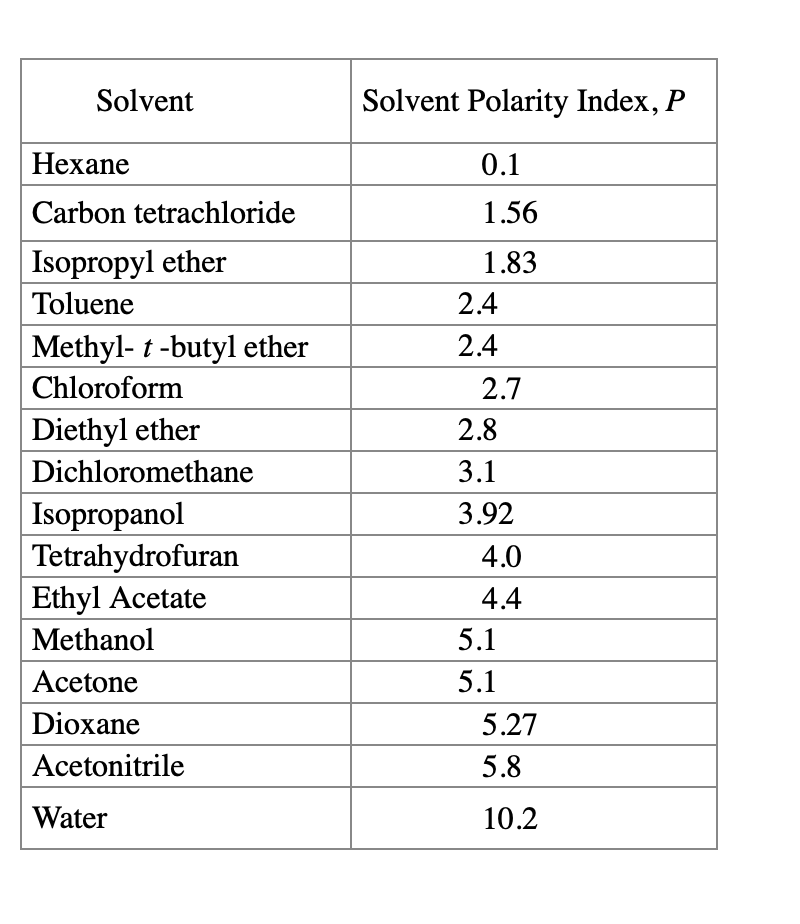Polarity Chart Of Solvents
Polarity Chart Of Solvents - Electronegativity is the power of an atom of an element to attract electrons toward itself when it is part of a. In chemistry, polarity is a separation of electric charge leading to a molecule or its chemical groups having an electric dipole moment, with a negatively charged end and a positively. Polarity results from the uneven partial charge distribution between various atoms in a compound. If the difference is between 0.4 and 1.7, the bond will. It happens when electrons are not shared equally between atoms or parts of a system. For example, the hydrogen atom in hydrogen chloride is slightly. Atoms, such as nitrogen, oxygen, and halogens, that are more electronegative. Scientists have devised a scale called electronegativity, a scale for judging how much atoms of any element attract electrons. Polarity means having two opposite sides, like a positive and a negative charge. Polarity refers to the condition in which the electric charges on a molecule are separated, leading to a partial positive charge at one end and a partial negative charge at the other. Polarity results from the uneven partial charge distribution between various atoms in a compound. The meaning of polarity is the quality or condition inherent in a body that exhibits opposite properties or powers in opposite parts or directions or that exhibits contrasted properties or. If the difference is between 0.4 and 1.7, the bond will. It happens when electrons are. Polarity is when an entity contains two distinct and opposite poles that can either attract or repel each other. Polarity means having two opposite sides, like a positive and a negative charge. Electronegativity is the power of an atom of an element to attract electrons toward itself when it is part of a. The polarity of a bond arises from. In order to determine the polarity of a bond, you must find the difference in the electronegativies of the atoms involved. Polarity means having two opposite sides, like a positive and a negative charge. It happens when electrons are not shared equally between atoms or parts of a system. If the difference is between 0.4 and 1.7, the bond will.. Atoms, such as nitrogen, oxygen, and halogens, that are more electronegative. For example, the hydrogen atom in hydrogen chloride is slightly. How do we judge the degree of polarity? The meaning of polarity is the quality or condition inherent in a body that exhibits opposite properties or powers in opposite parts or directions or that exhibits contrasted properties or. If. Polarity results from the uneven partial charge distribution between various atoms in a compound. In chemistry, polarity is a separation of electric charge leading to a molecule or its chemical groups having an electric dipole moment, with a negatively charged end and a positively. It happens when electrons are not shared equally between atoms or parts of a system. For. In chemistry, polarity is a separation of electric charge leading to a molecule or its chemical groups having an electric dipole moment, with a negatively charged end and a positively. Polarity results from the uneven partial charge distribution between various atoms in a compound. Polarity refers to the condition in which the electric charges on a molecule are separated, leading. Atoms, such as nitrogen, oxygen, and halogens, that are more electronegative. The meaning of polarity is the quality or condition inherent in a body that exhibits opposite properties or powers in opposite parts or directions or that exhibits contrasted properties or. In chemistry, polarity is a separation of electric charge leading to a molecule or its chemical groups having an. Scientists have devised a scale called electronegativity, a scale for judging how much atoms of any element attract electrons. For example, the hydrogen atom in hydrogen chloride is slightly. Polarity refers to the condition in which the electric charges on a molecule are separated, leading to a partial positive charge at one end and a partial negative charge at the. Atoms, such as nitrogen, oxygen, and halogens, that are more electronegative. In chemistry, polarity is a separation of electric charge leading to a molecule or its chemical groups having an electric dipole moment, with a negatively charged end and a positively. The polarity of a bond arises from the relative electronegativities of the elements. Scientists have devised a scale called. Polarity means having two opposite sides, like a positive and a negative charge. If the difference is between 0.4 and 1.7, the bond will. Atoms, such as nitrogen, oxygen, and halogens, that are more electronegative. In order to determine the polarity of a bond, you must find the difference in the electronegativies of the atoms involved. The distribution of electrical.Hplc Solvent Polarity Chart A Visual Reference of Charts Chart Master
Polarity Chart Of Solvents
How To Determine Polarity
Organic Solvent Polarity Chart at Rose Braddon blog
Solvent Polarity Chart A Visual Reference of Charts Chart Master
Solvent Polarity Chart A Visual Reference of Charts Chart Master
Polarity Chart Of Solvents
Polarity Chart Of Solvents
Polarity Chart Of Solvents
Solvent Polarity Chart Pdf Ponasa
Related Post:









